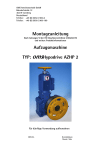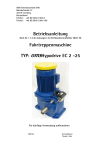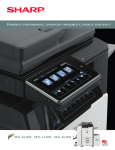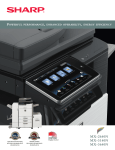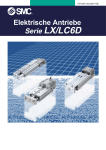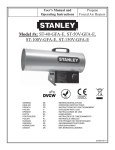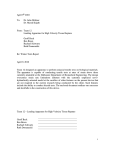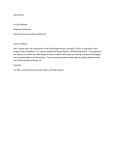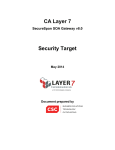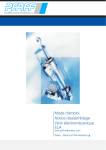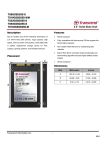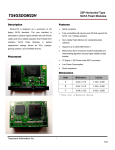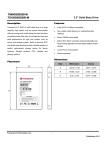Download Operating Instructions Elevator Machine Model
Transcript
OMS Antriebstechnik OHG Bahnhofstraße 12 36219 Cornberg Deutschland Telefon: +49 (0) 5650 / 969-0 Telefax: +49 (0) 5650 / 969-100 Operating Instructions According to Annex I of the EC Directive 98/37/EC Mechanical Equipment – Part 1.7.4 Elevator Machine Model: omsHypodrive AZHP1 Please archive this document for future reference OMS No. Date of Manufacture Month / Year Operating Instructions AZHP 1 (Technical changes reserved – Last Changes 09/2005) List of Contents Page 1 INTRODUCTION 4 2 SAFETY INSTRUCTIONS FOR OMS ELEVATOR MACHINES 5 Applicable Use None Applicable Use Warranty and Liability for the Elevator Drive Dangers, that are associated with the Elevator Drive Instructions for Safe Use Requirements and Qualification - Installation and Maintenance Personnel General Information 5 6 8 8 9 2.1 2.2 2.3 2.4 2.5 2.6 2.7 3 3.1 3.2 3.3 3.4 3.5 3.6 4 4.1 4.2 5 5.1 5.2 5.3 5.4 6 6.1 6.2 6.3 6.4 6.5 6.6 6.7 CONSTRUCTION AND FUNCTION Technical Data Noise Emission Information Manufacturers Identification Plate Modules and Additional Parts – Spare Parts Alternative Configurations Gearbox Variations and Applicable Mounting Configurations TRANSPORT AND STORAGE Transport Storage PREPARING FOR USE Assembly The Brake Emergency Release – Installation and Operation Installing the Rope Clamp 9 9 10 11 11 11 12 12 13 15 15 15 17 17 20 21 22 REGULAR USE AND MAINTENANCE 23 Recommended Routine Maintenance Error – Troubleshooting Errors Gearbox Oil Replacing the Traction Sheave Brake Maintenance Replacing the Incremental Encoder Replacing the Motor 23 24 24 27 28 30 31 Page 2 of 47 Operating Instructions AZHP 1 (Technical changes reserved – Last Changes 09/2005) 7 7.1 7.2 8 A B C D E F DISASSEMBLY Disassembly of the Elevator Drive Scrapping the Elevator Drive ADDENDUM Technical Data Oms Elevator Machine AZHP 1 Dimensions Sheet Elevator Machine AZHP 1 Electrical Connections Technical Data Disc Brake Traction sheave Technical Releases, Declaration of Conformity 32 32 32 33 34 35 36 39 44 46 Page 3 of 47 Operating Instructions AZHP 1 (Technical changes reserved – Last Changes 09/2005) 1 Introduction These instructions include pictograms for commenting on Warnings and Safety Issues. Application Tip: Additional Comments and Information, no danger involved Warning: of a general risk for the machine or a human safety hazard Warning: of dangerous currents, a liability of serious damage to health or death Warning: of hot surfaces, a liability of serious damage to health and / or serious material damage Warning: of crush injuries, a liability of serious damage to health Warning: of drawing in, a liability of serious damage to health Warning: DANGER Risk for the machine or a human safety hazard, a liability of serious damage to health or death Page 4 of 47 Operating Instructions AZHP 1 (Technical changes reserved – Last Changes 09/2005) 2 Safety Instructions for OMS Elevator Machines 2.1 Applicable Use The OMS-Elevator Machine AZHP 2 is for operating electrically driven sheave drive elevators for passengers or goods according to EN 81-1. The installation and use of the AZHP 2 for other purposes is not applicable. The OMS ANTRIEBSTECHNIK OHG are not liable for personal injury and or damage resulting from none applicable applications. All Planning, installations and maintenance work may only be carried out by qualified personnel. Qualified personnel are such who having studied for qualifications, or are experienced, or have received instruction and have the knowledge relating to the relevant standards and directives, safety regulations and local knowledge required to install and maintain the machine and be able to recognise and access the risks appertaining to this machine. (Qualified Personnel, as defined in IEC 364). This OMS – Elevator Drive is applicable to the 9th Directive of the Machine and Product Safety Law (9. Verordnung zum Geräte- und Produktsicherheitsgesetz (Maschinenverordnung) and the 98/37EC Machine Directive. It is part of a plant that it is to implemented in an elevator system and is therefore not liable for CE certification. The required manufacturers release is included within these instructions (Page 47). The commencement of regular use is not permitted until the erection (according to Elevator Directive 98/16 EC) has been completed in the pre determined elevator system and the CE label has been applied to the elevator to show that the safety requirements have been fulfilled for the machine as supplied by the manufacturer. All other required regulations and certificates (e.g. applicable to general use, maintenance and inspections) remain in force. The drive manufacturer only respects the warranty for operation and safety of the drive if it is has been erected, maintained and operated according to the printed specifications supplied individually with each drive. The warranty is void if the parameters outlined in the operating, maintenance and control documentation have been exceeded. An incorrect installation or incorrect use of the system, and or violation of the standards outlined above, lead to a complete and absolute none liability of the drive manufacturer. The motors should only be used in conjunction with frequency converters. Customer supplied frequency converters must be set up according to their instruction sheets, in order to comply with the requirements of the OMS-Elevator Machine. Page 5 of 47 Operating Instructions AZHP 1 (Technical changes reserved – Last Changes 09/2005) The OMS-Elevator Machine AZHP 1 is for operating elevators and has been designed for installation in an enclosed area (e.g. elevator shaft or machine room). OMS Drives may only be stored, erected and run in dry closed areas. The IQ/OQ representative and the user must ensure that adequate measures are taken to avoid a contamination with building dust and or dirt. The machine may only be stopped by the frequency converters and with the machine brake. OMS-Elevator machines may only be operated when in technically good condition and within the parameters as described by OMS. Applicable use also includes the following: • Working according to the supplied instructions, • Observing the regulatory safety and environmental requirements, • Adherence and observance of the Elevator documentation and regulations. 2.2 None Applicable Use OMS Drives may not be operated in potentially explosive or environmentally aggressive areas. The double circuit disc brake is only designed for a limited number of emergency stops. It’s use as a stand operation brake is not permissible. Further operation is not permissible once the pre determined wear points have been achieved. Permissible Limits: • • • • • max. Motor Speed: refer to technical documentation; max. Drive Wheel Load: refer to technical documentation; max. Number of Starts / Hour = 240; Local ambient temperature during operating min.: 5° C, max.: 40° C; The technical data and specifications on the Motor Data Label are only valid for an installation height up to h ≤ 1000m over NN. • Max. rel. Humidity: 85% at 20°C (none condensing) None applicable use also includes the following: - Dry operation without oil or use of a lubricant other than specified - Securing the drive with bolts weaker than those specified - Opening the Gearbox when installed on the drive Page 6 of 47 Operating Instructions AZHP 1 (Technical changes reserved – Last Changes 09/2005) Important: • All work related to; Transport, Electrical Connections, pre-Service Checks and Maintenance of the Drive System must be carried out by qualified technicians. Incompetent work can lead to serious personal injury and / or damage. Warning ! Special Notes appertaining to AZHP 1: • The machine is very efficient and has a very low natural friction rate. The machine operates immediately after the brake has been released. • During the installation of the Safety gear , it is important that the Machine Brake is available and that the brake can be operated at any time as and when required. • Using the elevator when the Emergency Brake is not operable is forbidden. The operator is responsible for the welfare and safe running of the elevator and all persons within. • Regular checks of the Safety gear and the Buffer must be carried out according to EN 81-1 Appendix E with an empty cabin and at reduced speed. Regular checks should not cause wear or stress which could lead to a lessening of elevator safety. Due to the inherent high level of efficiency, the drive should not be tested at speeds higher than vmax. ≤ 1,0ms-1. Otherwise serious damage could be caused to the drive and/or other parts of the elevator system. Alternatively, the checks can be performed using test weights and testing at nominal speed. • The cabin may only be pulled out of the Safety gear by moving the cabin in the opposite direction that caused the Safety gear to holt the elevator. The elevator Machine may only be operated in a situations with the maximum loads as given by the machine specification. All other methods, which would put additional static or dynamic loads on the for example the Traction sheave , Motor or Gearbox are forbidden. OMS will not respect any warranty claims resulting from practices other than those laid out in this document. • Ensure that the motor does not rest on or against the frame. If this should be the case, take appropriate action to remedy to free the motor. Take care to inspect the motor and the frame on each installation and document your actions. Page 7 of 47 Operating Instructions AZHP 1 (Technical changes reserved – Last Changes 09/2005) 2.3 2.4 Warranty and Liability for the Elevator Drive • The drive manufacturer only respects the warranty for operation and safety of the drive if it is has been erected, maintained and operated according to the printed specifications supplied individually with each drive. • The warranty is void if the parameters outlined in the operating, maintenance and control documentation have been exceeded. • The customer is responsible for the qualified installation of the drive by certified personal. • If damage or other problems are found on the elevator or the drive, then the system must be disabled, otherwise the operator will be liable for all damage and injury appertaining thereto. • An incorrect installation or incorrect use of the system, particularly with respect to the forbidden procedures outlined above, lead to a complete and absolute none liability of the drive manufacturer. • This is also applicable, when after damage has occurred, the operator and/or the installer and /or the maintenance company cannot supply a fully documented list of procedures relating to the erection, testing, maintenance and SOP’s of the elevator (Elevator Book etc). Dangers, that are associated with the Elevator Drive Our elevator drives are at the cutting edge of technology and are delivered in a safe operating configuration. Any changes made by that customer or his operative that may affect the inherent safety of the elevator drive are not permissible. The Drive Sheave and the Hand Wheel of the AZHP 1 are delivered by OMS without a safety cover and may only be operated in a secure Machine Room. Take care when working the Machine Room that an adequate safety distance is maintained away from the moving parts (yellow). The elevator supplier is responsible for installing safety shields if required. Page 8 of 47 Operating Instructions AZHP 1 (Technical changes reserved – Last Changes 09/2005) 2.5 Instructions for Safe Use If changes are observed during the service lift of the machine, e.g. wear, ageing etc. then the machine should be serviced and the changes dealt with, according to the OMS General- and Maintenance Instructions. The gearbox may only be opened by OMS at our factory site; the warranty will otherwise become invalid. 2.6 Requirements and Qualification - Installation and Maintenance Personnel All installations, maintenance work and repairs on the electrical parts of the machine may only be carried out by qualified personnel. Qualified personnel are such who having studied for qualifications, or are experienced, or have received instruction and have the knowledge relating to the relevant standards and directives, safety regulations and local knowledge required to install and maintain the machine and to be able to recognise and assess the risks appertaining this machine. (Qualified Personnel, as defined in IEC 364). OMS recommend that the technical personnel acquaint themselves with the machine before it is erected and taken into service. Please read the General- and Maintenance Instructions carefully, these instructions will aid you to find mistakes and technical deficiencies during the installation and operating life of the machine. 2.7 General Information Should damage occur during transport, or should the machine appear during erection to have errors or be damaged, please contact OMS and inform us of the damage or error. In case of damage caused by water, please contact OMS. A decision as to whether the damage or error can be rectified on site or not, can first be taken after the customer has contacted OMS. OMS will then decide if the machine can be taken into service or whether the machine should be returned with the original packaging – to OMS. Please retain the original packaging until after the machine has been taken into service. OMS will not accept responsibility for the correct installation and function of the elevator in the shaft. The responsibility for the correct installation and function of the elevator in the shaft lies with the elevator supplier and / or the elevator operator. Page 9 of 47 Operating Instructions AZHP 1 (Technical changes reserved – Last Changes 09/2005) 3 Construction And Function Due to the high efficiency ratio of approx. 92% the machine generates little excess heat, this ensures that the modules and aggregate parts and electronics are not exposed to excessive temperatures and therefore a detrimental effect – ageing and wear – on these parts due to temperature influence is kept to a minimum. Incremental Encoder: Between the HandWheel and the Motor Motoranordnung: stehend oder liegend, rechts oder links Disc Brake: Between the Motor and the Gearbox Traction Sheave: Drive Flange on the Gearbox side Getriebegehäuse mit 3-seitigen Standund Anflanschflächen Fig. 1: OMS-Elevator Machine AZHP 1, General Layout Page 10 of 47 Operating Instructions AZHP 1 (Technical changes reserved – Last Changes 09/2005) 3.1 Technical Data The efficiency of the OMS-Elevator Machine, relationship to the Elevator Cabin (1:1 or 2:1), Gearbox Version Specification, and possible installation constellations can be found in the Appendix: „Technical Data OMS – Elevator Machine AZHP 1“. All measurements and fitting details for the OMS Elevator Machine can be found in the Appendix: „Dimensions Sheet – Elevator Machine AZHP 1“. 3.2 Noise Emission Information All OMS elevator machines are subjected to a thorough noise emissions test before leaving our factory site. The test is conducted according to DIN EN ISO 11200 at a mean distance of 1 meter to the machine surface. Test procedure: The machines are driven through Frequency Converters, the actual level of effort reflects the known torque load and the drive speed. When working to the given limits, the machines emit the following noise emission parameters. Machine AZHP 1 Max. Sound Pressure Level LpA in dB(A) < 61,0 at < 1.500 min–1 If you have any further questions regarding noise emissions, please contact OMS. 3.3 Manufacturers Identification Plate The following information can found on the manufacturers identification plate. For Example: OMS ANTRIEBSTECHIK OHG 36219 CORNBERG GERMANY AZHP 1-15-23T-K405-010-A1 OMS Nr. - Baujahr xxxx-mmyy OMS-Auftrag: xxxxxx Kommission: xxxxxxxxx Übersetzung: 14,67/1 Model: AZHP 1 Ratio: 15 Motor type: 23 Encoder: T Traction sheave: K405 Brake type: 010 Mounting Configuration: A1 OMS-No. - xxxx- Month Year MMYY Page 11 of 47 Operating Instructions AZHP 1 (Technical changes reserved – Last Changes 09/2005) 3.4 Modules and Additional Parts – Spare Parts The OMS-Elevator Machine AZHP 2 consists of: • • • • • Gearbox complete Motor, complete with Incremental Encoder (between Hand wheel and Motor Cover) Brake system, complete Traction Sheave Safeguard device against Rope jumping (2-x) Optional: • Rope Clamp • Lever System (2-x, each for opening one Brake Circuit manually) • Traction Sheave Brake, a safety item for controlling the speed of an ascending cabin as specified in EN 81 3.5 Alternative Configurations The elevator machines can be supplied with the following alternative configurations: • • • • • • Electric motors : various sizes (optional fan less) Inkrementalgeber mit unterschiedlichem Signalausgang: SINUS, HTL, TTL Incremental Encoder with various signal outputs: SINUS, HTL, TTL Disc Brake: various torque ranges and electrical controls, with or without release levers Traction Sheave: various diameters (320, 400, 450mm, others optional) Safeguard device against rope jumping: Various fitting lengths, corresponding to the Traction sheaves, are available Page 12 of 47 Operating Instructions AZHP 1 (Technical changes reserved – Last Changes 09/2005) 3.6 Gearbox Variations and Applicable Mounting Configurations The OMS Elevator Machine AZHP 1 can be supplied in three different constellations. Looking towards the Drive Shaft and the Traction Sheave (dotted), these are as follows: Version A : Drive Shaft to the left of the longitudinal axis of the Motor Additionally, common to all three versions, the Motor can be positioned vertically erect or lying horizontally, above or below, with respect to the gearbox. The following diagrams (2-4) show these variations. According to the position, the Oil Dipstick and or Air Bleeder Valve will be found on the highest position on the Gearbox Casing). Fig. 2 – A 1 Fig. 3 – A 2 Motor horizontal, laid, above Fig. 4 – A 3 Motor horizontal, laid, below Page 13 of 47 Operating Instructions AZHP 1 (Technical changes reserved – Last Changes 09/2005) Comments: The standard position of the Terminal Connector Box on the Motor frame is in the direction of the Brake solenoid, but can be rotated with the Motor by 90° or 180°. To rotate the connector box, the motor fixing bolts must be unscrewed. Beforehand, disconnect the electrical supply and secure the machine against an unintentional power input. After repositioning the motor with the connector box, the bolts must be diagonally re-tightened (50Nm). If the force acting on the cable has a torque component which is perpendicular to the direction of the Gearbox fixing bolts, then an additional bracket must be used that supports the drive unit in this perpendicular direction, thus preventing the fixing bolts from being adversely affected by the sheer strength forces due to the elevator load. (If you have any questions on this issue, please contact OMS). fastening holes Bracket Force Fig. 5: Additional Bracket To ensure adequate lubrication and Gearbox efficiency, the elevator machine may only be erected as ordered. Page 14 of 47 Operating Instructions AZHP 1 (Technical changes reserved – Last Changes 09/2005) 4 Transport and Storage 4.1 Transport All elevator machines are inspected and passed prior to leaving our factory site. When you accept delivery of your machine, please check the packaging for signs of exterior damage. If you find damage which appears to have been caused in transit, then please document this damage in the presence of the delivery agent. The machine may not be taken into service. The Machine leaves the OMS factory in an Oil tight state. If the Machine has to be transported after having been installed, then the oil Dipstick and/or Air Bleeder Valve must be removed and replaced with the original OMS Oil Sealing Plugs. If the plugs are not available, please order new sealing plugs from OMS. The weight of the machine (without traction sheave) can be found in the table on page 34. The weights of the traction sheaves can also be found on this page. 4.2 Storage The Elevator Machine must not be stored outside and may not be exposed to outdoor weather conditions. If it is planned to store the machine for a longer period of time before installing it, then the measure must be undertaken to ensure an adequate conservation of the machine. A) Up to 3 Months Storage: No special storage requirements. Before the Elevator Machine is installed the following points should be observed: • All the Brake Parts must be inspected (activate the Brake in case there should be light corrosive spots on the Brake Drum). • Turn the Machine a few times by hand, (to ensure that the Motor Bearings are evenly greased). B) Up to 18 Months Storage: If it is planned to store the machine for a longer period of time before installing it, then the Machine can be ordered with the optional conservation kit. The Machine is then treated in the OMS factory and packed in a humidity proof yellow plastic foil. If this wasn’t the case, then: • At the latest, after six months Storage the Gearbox must be filled to the highest bolt hole with Oil. • Warning: Oil Type: See the yellow label; only use one sort of Oil. Page 15 of 47 Operating Instructions AZHP 1 (Technical changes reserved – Last Changes 09/2005) • After filling with Oil, the Machine must be packed in a humidity proof (yellow) foil: (this foil can be ordered from OMS). • Dry Storage is required Before the Machine is installed: • Reduce the Oil Level! to the standard level (ref. Chapter 6.3.1). • All the Brake Parts must be inspected (activate the Brake in case there should be light corrosive spots on the Brake Drum). • Turn the Machine a few times by hand, (to ensure that the Motor Bearings are evenly greased). • Install the Machine (Ref. Chapter 5. Preparing for use) C) Longer than 18 Months Storage: Optional factory conservation or procedures as in: B) Up to 18 Months Storage Dry Storage is required Before the Machine is installed: • Change all the Gearbox Oil. Take care to use the correct type of Oil and observe the Oil Level as outlined under: 6.3.1 and 6.3.3. • All the Brake Parts must be inspected (activate the Brake in case there should be light corrosive spots on the Brake Drum) • Turn the Machine a few times by hand, (to ensure that the Motor Bearings are evenly greased). • If the Machine cannot be turned by hand, or the movement is stiff, then the Motor Bearings may have to be replaced. • Install the Machine (Ref. Chapter 5. Preparing for use) After a lenghty storage period, the manufactures warranty will have run out. If a further warranty period is required, then the Machine may be returned to OMS to be refurbished (new Bearings etc.), this will incur some expense for the customer. Damage, that has been caused by negligible handling is not covered by our warranty specification. Page 16 of 47 Operating Instructions AZHP 1 (Technical changes reserved – Last Changes 09/2005) 5 Preparing For Use 5.1 Assembly It is important that the planned frame or foundation for the elevator machine(s) has been calculated with an adequate reserve. The frame must be stiff enough to resist the tension- and torque stresses that will occur during normal operation. 5.1.1 Elevator Machine, complete 1. Befestigen Sie die Maschine in der gewünschten Position über die vier Befestigungsgewinde in den Getriebefüßen. Die Einschraubtiefe entspricht der Gehäusestärke. Bolts : M 16 in Quality 10.9 200 Nm Torque: If required, supporting brackets and distancing plates should be used. (see examples, Fig. 5). Pre Use Requirements: Exchange the labelled sealing plug on the Gearbox Casing with the supplied Oil Dipstick or the supplied Air Bleeder Valve. Take care to observe the correct positioning of the Gearbox (See Figs. 2-4). Retain the sealing plug for possible future transportation of the Machine. Important: The Gearbox has been sealed against oil leakage during transport. The Gearbox is airtight due to the sealing plug(s). If the Gearbox were to be taken into use with the sealing plug(s) in place, then excess pressure may build up in the Gearbox, eventually causing the Gearbox to leak – oil will be pressed out through the Shaft Gaskets. The Oil Dipstick does not seal the Gearbox. Electrical Connections Only qualified personnel may open the Terminal Box on the Motor and connect the machine to the electrical supply. Only qualified personnel may carry out repairs and service work on the electrical parts of the machine. Disconnect the main switch beforehand and secure the switch against unintended operation!! The Safety Rules for the Construction and Erection of Elevators“ according to DIN – EN 81-1 must be observed at all times. Page 17 of 47 Operating Instructions AZHP 1 (Technical changes reserved – Last Changes 09/2005) Important: The electrical system for the machine has been designed according to: EN 60 204 – 1. In order to ensure failure free function of the machine, it is recommended that all wiring should be shielded according to the standard EMV regulations. Avoid ground loops when connections include multiple shields. Procedure: 1. Motor: The electrical connections should be connected as per the diagram in the Motor Terminal Box. (See also: Appendix, Electrical Connections). Should a different wiring exit position be required, the Terminal Box can be turned by loosening the internal fixing screw and repositioning the Terminal Box. Please take care when adjusting the fine wiring of the temperature monitor switches. 2. Frequency Converter: The connection and setting up of the Converter together with the OMS-Elevator Machine must be carried out according to the instructions supplied with the Converter. 3. Incremental Encoder: The Incremental Encoder (between Motor Cover and Hand wheel) is supplied with a 5m-shieded cable and a 2 row 15-pin connector, which should be connected to the Frequency Inverter. The shielding is wired to the plug casing, PIN 12 and the Incremental Encoder. According to the Incremental Encoder used, the wiring for the connector can vary (See Appendix, Electrical Connections, Incremental Encoder). Should the Connector on the Frequency Inverter be non-compatible, adapters and longer cables are optionally available (See Appendix). 4. Disc Brake: The connection of the Brake Magnet (Two Circuit Disc Brake), should be carried out in respect to the local elevator configuration: a) If the machine is accessible in a service room, then both Brake Magnet Circuits may be connected to a single Control Module. b) in case the machine is installed in an inaccessible position, and if emergency control and checking of each circuit will be done purely electrical, then each Magnet may be connected to two separate Control Modules, which in turn may be individually wired (for checking the individual Brake Circuits, See 5.2.2-b1) Page 18 of 47 Operating Instructions AZHP 1 (Technical changes reserved – Last Changes 09/2005) 5.1.2 Safeguard Device against Rope Jumping The safeguard devices must be fitted to the elevator machines. The Rope Jump Devices can be fitted after the cables have been installed. They must be adjusted so that they do not rub or bind and there must be a gap between the Ropes of between max. 1 – 2 mm. The safeguard device against rope jumping is supplied twice and consists of the following components each: Bolt Safeguard device against rope jumping cheese-head screw M16 x 25 Hex screw M10 x 25 Fig. 6: Module, safeguard device against rope jumping Adjustment according to the Drive Sheave diameter: 1. Loosen the screw M10 x 25 and push the Safety Bolt along the slit to the required position. Page 19 of 47 Operating Instructions AZHP 1 (Technical changes reserved – Last Changes 09/2005) 5.2 The Brake 5.2.1 Setting the Brake The Brake has been set up by OMS. The Brake set up should not be altered. Before taking the AZHP 1 into service, the function ability of the Brake should be checked. If the Brake should show any adverse behaviour, then we recommend changing the complete Brake System. See the notes: „Erection and Instructions for the Disc Brake“. 5.2.2 Control, both Brake Circuits: Comments: The procedure for conducting the final check of the brakes as part of the Elevator Acceptance Test is not described in detail here. Please refer to the relevant safety regulations and requirements. The following points a) to b2) are only relevant, when an individual control of each Brake Circuit is required. a) For an accessible machine: Is the machine accessible in a Service Room or Elevator Shaft, then it is possible to laterally open the Brake Levers and simply check the movement of each Brake Lever. (See the technical description of the Brake system in the Appendix) b) For an inaccessible machine: If the machine has been installed in an inaccessible position, then an electrical or mechanical Remote Control will be required: b1) External electrical Remote Control: The Solenoids of the Brake Magnet can be individually activated. Thus, it is possible to individually operate the two braking circuits b2) Mechanical Remote Control: To check the Brake Levers individually two linkages can be optionally supplied. A bracket is fitted to the Gearbox Casing to support the linkages. The linkages must be ordered together with the AZHP 1 for the brake. Page 20 of 47 Operating Instructions AZHP 1 (Technical changes reserved – Last Changes 09/2005) 5.3 Emergency Release – Installation and Operation The required Emergency Instructions – that must be placed adjacent to the Emergency Release – are not described here. Please refer to the relevant safety regulations and requirements. a) for an accessible machine: Is the machine accessible in a Service Room or Elevator Shaft, then the Brake can be opened with the standard Lever. If required the Elevator Cabin can be moved by turning the Hand Wheel on the Motor. b) By Remote Control: If the machine has been installed in an inaccessible position, then an electrical or mechanical Remote Control will be required: b1) external Electrical Remote Control: If an Emergency Power Source is available, then the Electromagnets and the Motor can be wired into the Emergency Power. b2) mechanical Remote Control: The brakes can be opened using the (optional) external Brake Lever linkages. Page 21 of 47 Operating Instructions AZHP 1 (Technical changes reserved – Last Changes 09/2005) 5.4 Installing the Rope Clamp During repair and revision periods a (optionally available) Rope Clamp can be fitted, so avoiding Rope slippage through the Traction Sheave. The Rope Clamp must be fitted to one of the openings in the Traction Sheave. (See Fig. 7). Take care, that the lug on the Clamp Bracket snaps behind the frame that follows the opening. Thus preventing a slipping of the Rope Clamp after releasing the Locking Bolts. Both Locking Bolts should be tightened so that the inner and outer bars lie parallel to each other. The inner bar is supported by the frame thus ensuring that all the ropes equally support the resulting forces. Outer bar Traction Sheave Window in Frame of the Traction Sheave Inner bar Fig. 7: Rope Clamp, fitted to the side of the Traction Sheave When using a Rope Clamp ensure that: 1. It cannot collide with other parts of the machine. 2. It cannot get tangled in the vertical elevator ropes. 3. It cannot block the machine. 4. That the next following Rope Jumping Safeguard Device cannot support or obstruct the Rope Clamp. If necessary remove the Bolt from the Safeguard Device. It is not permissible to raise the cabin out of the trap by using the Rope Clamp, an additional „loose rope“ and letting the balance weight fall. Page 22 of 47 Operating Instructions AZHP 1 (Technical changes reserved – Last Changes 09/2005) 6 Regular Use and Maintenance The Safety- measures and instructions for the erection and use of elevator machines as according to: DIN EN 81: “Safety rules for the construction and installation of lifts – Particular applications for passenger and goods passengers lifts”, Part 1 “Electrically operated passenger and goods lifts”, “Technical rules for lifts” and other relevant regulations and instructions must be observed at all times. The operator is responsible for the safe installation, control and maintenance according to the applicable regulations and standards. 6.1 Recommended Routine Maintenance Item Maintenance Frequency Source Oil Level, Control Every 3 Months Ref. 6.3.1 Oil Change Ref. 6.3.2 Ref. 6.3.3 Bearing, Check (Audible) In accordance with the regular elevator maintenance schedule, at least annually. Brake, Check In accordance with the regular elevator maintenance Ref. 6.5 schedule, at least annually. In accordance with the reguTraction Sheave, Check for lar elevator maintenance wear schedule, at least annually. Electrical Wiring and Con- In accordance with the regunections, Check for wear lar elevator maintenance and loose connections schedule, at least annually. Cleaning the machine sur- When required, at least anfaces nually. Safety installations and mechanisms, Check for presence and function In accordance with the regular elevator maintenance schedule, at least annually. Page 23 of 47 Operating Instructions AZHP 1 (Technical changes reserved – Last Changes 09/2005) 6.2 Error – Troubleshooting Errors Error Possible Cause Answer Unusual, none rhythmic operating noises • Grinding / Scraping Bearings • Knocking / Jumping Gears • Regulator adjustment • Call Customer Service • Check the parameters of the Frequency Converter • Call Customer Service • Check all electrical connections Oil Leak • Seal damaged Brake does not switch • Wiring is not OK 6.3 Gearbox Oil 6.3.1 Controlling the Oil Level Check the oil level at every maintenance opportunity, the oil level is checked using the Oil Dipstick. • The Oil Level must lie between the marks 6.3.2 Controlling the Oil Viscosity We would like you to check the condition of the Gearbox Oil regularly. Control: • Check the oil viscosity by letting a drop of oil fall from the Dipstick onto a piece of white paper. Compare the colour of the oil with the Oil Check Card. Page 24 of 47 Operating Instructions AZHP 1 (Technical changes reserved – Last Changes 09/2005) Fig. 8 Oil Check Card • Oil colour straw yellow to mid brown: Oil good to still usable • Oil colour mid brown to dark brown: Oil change required • Oil colour dark brown to black: Oil no longer usable 6.3.3 Oil change interval 1. Oil change next Oil change - 12 months after taking machine into operation after app. 15.000 operating hours or 60 months 6.3.4 Oil Change Should you consider an oil change to be required, please adhere to the following instructions. Only change the oil when the gearbox surface temperature is at below body temperature, otherwise danger of burning your skin exists Should you consider an oil change to be required, please adhere to the following instructions: 1. Place a suitable container below one of the Oil Drain Screws under the Gearbox. The Gearbox has a capacity: 4,3 Ltr. 2. Carefully open the Oil Drain Screw. Page 25 of 47 Operating Instructions AZHP 1 (Technical changes reserved – Last Changes 09/2005) 3. After all the oil has run out, replace the Drain Screw and tighten it. 4. Replace the oil, either through the Oil Dipstick opening or through the Air Release Valve opening. 5. Observe the filling level. 6. Only fill the Gearbox with the authorised oil: Castrol SAF-XO SAE 75W-90 (Never mix with mineral oil!) (Please contact OMS before using oil from other manufactures) 7. Close the opening, either with the Oil Dipstick or the Air Release Valve. If oil is spilled during the oil change, then the spilled oil should be cleaned up immediately. Used Oil is Special Waste! Page 26 of 47 Operating Instructions AZHP 1 (Technical changes reserved – Last Changes 09/2005) 6.4 Replacing the Traction Sheave The Traction Sheave is, like the Elevator Ropes, prone to wear and must be changed according to the regulations governing Elevators. The Traction Sheave is attached to an Adapter Flange on the Drive Shaft. The Flange has been attached in the OMS factory with a pre defined torque, and is considered a part of the Gearbox and may not be removed by the customer. How to change the Traction Sheave: 1. Disable and secure the complete elevator system. (Observe the instructions of the elevator manufacturer). 2. Loosen and remove the cable from the Traction Sheave. (Observe the instructions of the elevator manufacturer). 3. Should the Safeguard Device against cable jumping require adjustment, please consult Chapter 5.1.2. 4. Secure the Traction Sheave against falling – use a rope loop – and remove the fixing bolts M12 x 60. 5. Pull the Traction Sheave from the hub of the Drive Shaft. If necessary use two bolts M20, of at least 65mm length, place the bolts in the preformed Puller Holes. Remove the remaining Clamping Pins from the screw threads and clean the centre hub. Smooth down the uneven points that may have been formed by the Puller Bolts. 6. Place the new Traction Sheave on the centre hub. Secure the Traction Sheave against falling – use a rope loop. Ensure that the Traction Sheave has complete contact around the Flange. Rotate the Traction Sheave on the Drive Shaft until the Bolt holes are aligned. 7. Drive the 8 new (supplied) Clamping Pins, DIN EN ISO 13337 – 16 x 36, fully in to the threaded holes until they lie flush against the threaded area. Bolt the Drive Wheel to the Flange using the required Bolts. (Torque: 85 Nm) Damaged bolts should be replaced (M12 x 60 - 8.8). 8. Reinstall the Elevator ropes (Observe the instructions of the elevator manufacturer). Page 27 of 47 Operating Instructions AZHP 1 (Technical changes reserved – Last Changes 09/2005) 6.5 Brake Maintenance The Disc Brake is normally maintenance free. Brake Disc wear can be considered as being minimal. 6.5.1 Controlling the Brake The Brake is fitted with Sensors that monitor the Brake function (opening and closing) (See: Appendix, Technical Data, Disc Brake) Pease Check the Brake function regularly) If the Brake should develop and abnormally, which cannot be attributed to an electrical problem, then the Brake can be disassembled according to the manufacturers instructions. (See 5.2 and Appendix, Technical Data, Disc Brake) 6.5.2 Opening or Replacing the Brake: The Motor must be dismounted before attempting to replace the Disc. Block the movement of the Elevator Cabin and Balance Weight; please refer to the relevant safety regulations and requirements. • Disassemble all the electrical connections from the Motor and the Brake. • Remove the 4 Bolts from the Motor Base above the Brake Flange Casing. Dismount the Motor using a rope loop through the Lifting Bolts attached to the Motor. Do not attempt to lift the Motor by the Hand Wheel! • Remove the Manual Brake Lever. • Remove the 3 bolts from the Brake and remove the Brake. (see Fig. 9) • After the Brake has been replaced, re-assemble the Motor and Brake in reverse order. When replacing the Brake, observe the manufacturers instructions. When replacing the Flange Casing, take care when passing the electrical wiring for the Brake through the window in the Flange Casing. • Tighten the Flange Casing diagonally (Torque 50 Nm) • When reassembling the Motor, observe the comments: Replacing the Motor Page 28 of 47 Operating Instructions AZHP 1 (Technical changes reserved – Last Changes 09/2005) 4 x Fixing Boreholes for the Motor Manual Braking Lever Transmission Socket: Gearbox, Brake and Motor 3 x Fixing Bolts for the Brake Fig. 9: Looking at the Flange casing and Brake, the Motor has been removed Page 29 of 47 Operating Instructions AZHP 1 (Technical changes reserved – Last Changes 09/2005) 6.6 Replacing the Incremental Encoder Locking Screw Radial Securing Screws Locking Plate Abb. 10 Securing the Incremental Encoder Fan Cover Fig. 11: Incremental Encoder Support • Remove the Hand wheel, including Central Locking Screw and Washer. • Loosen the two Radial Securing Screws that can be found under the Incremental Encoder (s. Fig. 10). • The Locking Plate is secured with a screw. • The re-assembly of the Incremental Encoder should be carried out in reverse order. Page 30 of 47 Operating Instructions AZHP 1 (Technical changes reserved – Last Changes 09/2005) 6.7 Replacing the Motor Place the new Motor adjacent to the old Motor and compare the Technical Data. Disable and secure the complete elevator system (Observe the instructions of the elevator manufacturer). Be careful not to pull out the sleeve of the disk brake when removing the motor. Otherwise the brake will become inoperable and the cabin and the counterweight will fall upwards / downwards respectively. Warning: The Motor can become hot during operation – take care, contact with a hot Motor can result in burn injuries! • Remove the four bolts on the Motor Base, which can be found above the Flange Casing. • Lift the Motor, using Eye Ring Bolts and a rope loop; the Eye Ring Bolts can be attached laterally to the Motor. • Warning: if the Motor should fall, then it may become damaged, the Motor may not be lifted by the Hand wheel. • After replacing the Motor carry out the above-mentioned steps in reverse order, carefully tightening the Motor Bolts diagonally. (Torque 50 Nm) Comments: The Motor and gearbox are centred with a Transmission Socket; therefore take great care when fitting the Motors to the Gearbox: a) Vertical Motor: Initially, only tighten the Motor Fixing Bolts lightly. Carry through a complete run through test with the Motor and finally tighten the Motor Fixing Bolts to their final standard torque. b) Horizontal Motor: The Motor must be hanging horizontally in a rope loop, guide the Drive Shaft carefully into the Transmission Socket and fasting the Motor Fixing Bolts while the Motor is still supported by the rope loop. Take care that the Motor doesn’t twist or shear and that the Drive Shaft cleanly fits into the Transmission Socket! Page 31 of 47 Operating Instructions AZHP 1 (Technical changes reserved – Last Changes 09/2005) 7 Disassembly 7.1 Disassembly of the Elevator Drive Remove the Oil Dipstick and replace it with the supplied Sealing Plug. The Gearbox is not sealed when the Oil Dipstick is fitted. To disassemble the Elevator Drive carry through the same procedure as during the assembly – but in reverse order. 7.2 Scrapping the Elevator Drive • The Gear Wheels, Axles and Bearings can be scrapped as standard steel scrap. • The forged parts can also be scrapped as standard steel scrap. • The Motor Winding and the Brake Unit are mainly brass and bronze and must be scrapped as such. • Oil and Grease must be removed and disposed of accordingly. Page 32 of 47 Operating Instructions AZHP 1 (Technical changes reserved – Last Changes 09/2005) 8 Addendum Technical Data OMS Elevator Machine AZHP 1 Dimensions sheet OMS Elevator Machine AZHP 1 Motor Positioning of Version A Electrical Connections Technical Data, Disc Brake (Manufacturers Data Sheet) Currently used: Disc brake Type KEB COMBISTOP 71.642.00-4001 Technical Releases, Conformity Declarations (Page 1 and 2) We shall be pleased to receive your questions, comments and suggestions: OMS Antriebstechnik OHG Bahnhofstraße 12 36219 Cornberg Tel.: Fax: 0 - 5650 – 969 – 0 0 - 5650 – 969 - 106 E-Mail: [email protected] Homepage: http://www.oms-antrieb.de Page 33 of 47 ADDENDUM A Technical Data OMS Elevator Machine AZHP 1 (Technical changes reserved – Last Changes 09/2005) Gear: input-revolution, max: efficiency: typical backlash range : sound pressure level (1500 rpm /nominal load): car suspension gear ratio Output shaft: max. torque max. axial weight for car load up to. for car speed up to: n = 1800 rpm η,n = > 92 % 5 to 15 arc. minutes LpA = 59 dB(A)) 2:1/1:1 14,67 i T F Q v 930 Nm 35 kN 630 kg (options upon request) 1,6 m/s Motor : three phase induction motor: type / diameter B: motor nominal torque up to: encoder: (for frequency converter only) 4-pole, IP 54, motor protection: PTC, integral fans, Typ: 112 / B = 220 Typ: 132 / B=246 T,n = 51,4 Nm HTL, TTL, Sinus Brake: 2-circle safety disc brake Traction sheave: diameter: weight, ca.: width: rope diameter: number of ropes: D = 320, 400, 450, mm *) G = 34, 37, 46, kg *) C = 112 mm *), F = 176 *) 125mm, (only for dia. 320 mm) *) D, s = 10 mm *) n = 4 – 6 *) *) options upon request Dimension: total height A according to motor dimension (weight of drive, all inclusive without traction sheave): Motor Typ Pnenn kW Tnenn Nm Nnenn min-1 f Hz A mm G kg 112 112 112 112 132* 132* 132* 132 4,2 3,8 5,5 7,5 5,5 7,5 5,0 9,0 22,3 32,4 30,5 41,4 36,5 49,8 51,4 49,6 1725 1120 1725 1730 1440 1440 930 1735 60 40 60 60 50 50 33,3 60 843 863 863 960 855 905 905 948 152 159 157 170 178 197 197 186 * fan less motor Page 34 of 47 ADDENDUM B Dimensions Sheet Elevator Machine AZHP 1 Motor Alignment Version A Page 1 (Technical changes reserved – Last Changes 09/2005) Page 35 of 47 ADDENDUM C Electrical Connections – Elevator Machine AZHP 1 (Technical changes reserved – Last Changes 09/2005) 1. Wiring Diagram for Asynchronous Motor Junction Box: (Shorting Bars for Star – Connection) 2. Wiring Diagram for Incremental Encoder, Extensions & Adapter 2.1 Connections, Encoder ( Sinus / TTL / HTL ) Output SUB D 15 Pol. Plug PIN - No. 1 2 3 4 5 6 7 8 Signal A+ A+5V GND B+ BN+ N- PIN - No. 9 10 11 12 13 14 15 casting Signal shield shield A ±: Channel 1, B ± : Channel 2, N ±: Reference 1 8 9 15 View from the Plug side (Comment: the shielding connection to PIN 12 is only required for SIN/COS Encoder to “Dietz FU) 2.2 Encoder Extension Cable, l = 5m SUB D 15 Pol. Socket to SUB D 15 Pol. Plug OMS Part No. 3034 0060 PIN – No. 1 2 3 4 5 6 7 8 Signal A+ A+5V GND B+ BN+ N- PIN – No. 9 10 11 12 13 14 15 casting Signal shield shield A ±: Channel 1, B ± : Channel 2, N ±: Reference PIN - No. 1 2 3 4 5 6 7 8 Signal A+ A+5V GND B+ BN+ N- PIN - No. 9 10 11 12 13 14 15 casting Signal shield shield A ±: Channel 1, B ± : Channel 2, N ±: Reference Page 36 of 47 ADDENDUM C Electrical Connections – Elevator Machine AZHP 1 (Technical changes reserved – Last Changes 09/2005) 2.3 Connections, Adapter for „KEB“ Frequency Converter, l = 0,25m SUB D 15 Pol. Socket to SUB D 15 Pol. Plug - 3 - rows OMS No. 3034 0061 PIN - No. 1 2 3 4 5 6 7 8 Signal A+ A+5V GND B+ BN+ N- PIN - No. 9 10 11 12 13 14 15 casting Signal shield shield A ±: Channel 1, B ± : Channel 2, N ±: Reference PIN - No. 1 2 3 4 5 6 7 8 Signal ABA+ PIN - No. 9 10 11 12 13 14 15 casting Signal B+ +5V GND RR+ shield A ±: Channel 1, B ± : Channel 2, R ±: Reference 1 5 6 10 11 15 viewed from the plug side 2.4 Connections, Adapter for „Ziehl-Abegg“ Frequency Converter, l = 0,25m SUB D 15 Pol. Socket to SUB D 9 Pol. Plug OMS Part No. 3034 0102 PIN - No. 1 2 3 4 5 6 7 8 Signal A+ A+5V GND B+ BN+ N- PIN - No. 9 10 11 12 13 14 15 casting Signal shield shield A ±: Channel 1, B ± : Channel 2, N ±: Reference PIN - No. 1 2 3 4 5 6 7 8 9 casting Signal A+ B+ +5V GND ABGND shield A ±: Channel 1, B ± : Channel 2 1 5 6 9 viewed from the plug side Page 37 of 47 ADDENDUM C Electrical Connections – Elevator Machine AZHP 1 (Technical changes reserved – Last Changes 09/2005) 2.5 Connections, Adapter for “Danfoss” Frequency Converter, l = 0,25m SUB D 15 Pol. Socket to Phoenix Socket, 8 Pol. OMS Part No. 3034 0126 PIN - No. 1 2 3 4 5 6 7 8 Signal A+ A+5V GND B+ BN+ N- PIN - No. 9 10 11 12 13 14 15 casting Signal shield shield PIN - No. 1 2 3 4 5 6 7 8 A ±: Channel 1, B ± : Channel 2, N ±: Reference Signal +5V GND A+ AB+ BN+ Nshield A ±: Channel 1, B ± : Channel 2, N ±: Reference Plug: Phönix Part. No. 184021 2.6 Connections, Adapter open ended cable, l = 0,25m SUB D 15 Pol. Socket to 9 open wires OMS Part No. 3034 0127 PIN - No. 1 2 3 4 5 6 7 8 Signal A+ A+5V GND B+ BN+ N- PIN - No. 9 10 11 12 13 14 15 casting Signal shield shield A ±: Channel 1, B ± : Channel 2, N ±: Reference Wire - No. 1 2 3 4 5 6 7 8 9 Signal +5V A+ AB+ BN+ NGND shield A ±: Channel 1, B ± : Channel 2, N ±: Reference Page 38 of 47 SW2 black / schwarz blue / blau blue / blau grey / grau black / schwarz brow n / braun blue / blau grey / grau SW3 R4 275V R3 470k R5 R6 275V 470k GL2 B500C3200/2200 3) TEST KREIS 1 Date: Size A3 Wednesday, March 06, 2002 Document Number Scheibenbremse.dsn S 3B Sheet 3 Si 2 T 1,6 A 1 Scheibenbremse Typ W 2) NORMAL OPERATION 3) TEST CIRCUIT 1 2) NORMAL BETRIEB Title TEL: +49(0)5650-969-0 FAX: +49(0)5650-969-100 1) TEST CIRCUIT 2 C2 470 nF 250V~ 1) TEST KREIS 2 3 Si 1 S 3A T 1,6 A 1 Schlüsselschalter C1 470 nF 250V~ OMS Antriebstechnik OH G Bahnhofstraß e 12 D-36219 Cornberg Magnet Ansteuerung: 207V DC Disk Brake Control Voltage: 207V D C SW4 U Rb 275V SW3, SW 4 with Ra, Rb OPTION R2 275V GL1 B500C3200/2200 Switch Position S 3 Disc Brake Control : R13 275V U R11 275V U R1 275V Schalterstellung S 3 Magnet - Ansteuerung : Leiterplatte PCB U R12 275V U Ra 275V U Function Monitoring Circiut 2 M2b brow n / braun black / schwarz U R10 275V U Funktionsüberw achung Kreis 2 DISC BRAKE,C ir cuit 2 M2a M1b M1a SW1 U MAGNET BREMSE, Kreis 2 DISC BRAKE,C ir cuit 1 MAGNET BREMSE, Kreis 1 Function Monitoring Circuit 1 Funktionsüberw achung Kreis1 black / schwarz blue / blau SCHALTSCHRANK CONTROLLER CABINET + + KLEMMKASTEN JUNCTION BOX U - MASCHINE MACHINE 1 of 1 Rev 1 Kreis 2b Circuit 2b Kreis 2a Circuit 2a Neutral Disc Brake Control L1 Steuerung L1 Magnet NETZ - L1 MAINS - L1 Kreis 1b Circuit 1b Kreis 1a Circuit 1a ADDENDUM D Electrical Data Disc Brake – Elevator Machine AZHP 1 (Technical changes reserved – Last Changes 09/2005) Suggestion for wiring diagram for the electrical disc brake. Checking of the two independently operating braking systems is possible by electrical control. To emergency operation an UPS is necessary. In case of a failure of one of the coils of a disk brake, the remaining functioning half of the coil can open the brake for approx. 1 min. Operating voltage at disk brake: 207 V DC Page 39 of 47 F u n c t i o n M onitor C i r c uit 2 Funktionsüberwachung Kreis 2 D IS K B R A K E , Circuit 2 MAGNET BREMSE, Kreis 2 D IS K B R A K E , Circuit 1 MAGNET BREMSE, Kreis 1 F u n c t io n M onitor C i r c uit 1 Funktionsüberwachung Kreis1 SW2 M2b M2a M1b M1a SW1 US ER OP T I ON: Co n tact in DC Path: ~ 1 2 1 of 1 R ev 1 C2 R2 470k 470nF 250V~ Size Title A2 Page 40 of 47 Scheibenbremse.dsn Date: Monday, September 23, 2002 Document Number Scheibenbre mse Typ W TEL: +49(0)5650-969-0 FAX: +49(0)5650-969-100 OMS Antriebstechnik OHG Bahnhofstraße 12 D-36219 Cornberg Disk B rake C o n t rol L1 C i r cuit 2b C i r cuit 2a R1, C1 and Si 1 have to be suppl ied by the elevator buil der! R1, C1 und Si1sind vom Anlagenba uer beizustellen! Neutral S te u e r u ng L1 Magnet Kreis 2b Sheet ~ O MS G l e i ch r i chter R e c t ifier 3038 0004 2 1 Si 1 T 1,6A C i r cuit 1b Kreis 1b black / schwarz 5 4 3 6 5 4 3 6 R1 C1 470k 470nF 250V~ C i r cuit 1a Kreis 1a SCHALTSCHRANK CONTROLLER CABINET Kreis 2a SW4 blue / blau blue / blau grey / grau black / schwarz brown / braun blue / blau grey / grau black / schwarz brown / braun black / schwarz blue / blau SW3 ~ KLEMMKASTEN JUNCTION BOX ~ MASCHINE MACHINE ADDENDUM D Electrical Data Disc Brake – Elevator Machine AZHP 1 (Technical changes reserved – Last Changes 09/2005) Suggestion for wiring diagram for the electrical disc brake Type W, Warner Electric. This version is intended for a separate, mechanical remote brake release for emergency operation or for testing. Input Voltage at Junction Box: 230 V AC ADDENDUM D Electrical Data Disc Brake – Elevator Machine AZHP 1 (Technical changes reserved – Last Changes 09/2005) Page 41 of 47 ADDENDUM D Electrical Data Disc Brake – Elevator Machine AZHP 1 (Technical changes reserved – Last Changes 09/2005) Page 42 of 47 ADDENDUM D Electrical Data Disc Brake – Elevator Machine AZHP 1 (Technical changes reserved – Last Changes 09/2005) Page 43 of 47 APPENDIX E Traction Sheave for OMS – Elevator Machine AZHP 1 (Technical changes reserved – Last Changes 09/2005) Two pieces Traction Sheave with a flanged connector, Material: GG 25 (ca. 230HB) Optional: Hardened Guides 50HRC. Standard Traction Sheave –Undercut Wedged Guides C t d γ 2,5 mm D β Special Traction Sheave – Undercut Semicircular Guides C t d γ 2,5 mm D β Page 44 of 47 APPENDIX E Traction Sheave for OMS – Elevator Machine AZHP 1 (Technical changes reserved – Last Changes 09/2005) Special Traction Sheave – Wedged Guides sans Undercut C t d γ 2,5 mm D Available Traction Sheaves Type Traction sheave guides D in mm z D K3.. 320 6-10 8 K4.. 400 5-6 8-10 K4.. 450 5-6 8-11 K5.. 500 6 8-11 K5.. 560 6 8-11 K5.. 560 6-7 8-14 K6.. 650 6 8-11 K6.. 650 6-7 8-14 K7.. 750 4-7 8-14 Special Traction sheaves 420-950 3-8 8-14 C 125 112 112 112 112 130 112 130 90+112+130 90-140 Dimensions T β° 12-17 80-104 17 80-104 17 80-104 17 80-104 17-20 80-104 17-20 80-104 17-20 80-104 17-20 80-104 17-20 80-104 any 80-104 γ° 35-45 35-45 35-45 35-45 35-45 35-45 35-45 35-45 35-45 35-45 Weight kg 34 40 46 52 59 65 86 96 - Page 45 of 47 APPENDIX F Technical Releases for OMS – Elevator Machine AZHP 1 Page 1 (Technical changes reserved – Last Changes 09/2005) Page 46 of 47 APPENDIX F Technical Releases for OMS – Elevator Machine AZHP 1 Page 2 (Technical changes reserved – Last Changes 09/2005) Declaration of Conformity According to the EC Machine Directive 98/37/EC, Appendix II B Description : Drive Unit for Elevators according to EN 81-1 Type of Machine : AZHP 1 Machine No. : Machine Data : According to the data recorded on the Manufacturers Plate Machine, composed of the following components 1. 2. 3. 4. Hypoid Bevel; (1 stages) Motor; (3 Phase AC Motor, Motor Type B5 S, Protection Class IP 54, Insulation Class F) Braking Unit; (2 Circuit Disc Braking Unit) Traction Sheave, Safeguard against rope jump off Applicable EC Directives: EC Machine Directive 98/37/EC EC Low Voltage Directive 73/23/EC EC Prevention of Electro- Magnetic Emissions 89/336/EC Herewith we declare that the above mentioned machine in it’s original delivery state is in accordance with EC / DIN / ISO safety and health requirements due to it’s conception, construction and implementation. This machine may only be operated in elevator systems which adhere to the applicable directives and guidelines. Dr.-Ing. Michael Militzer / Geschäftsleitung OMS Antriebstechnik OHG; Bahnhofstraße 12; D-36219 Cornberg Page 47 of 47
















































